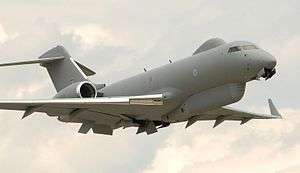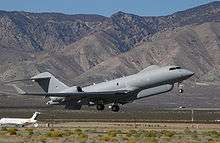Raytheon Sentinel
| Sentinel R1 | |
|---|---|
 | |
| ZJ692 landing at Waddington Air Show 2006 | |
| Role | Airborne battlefield and ground surveillance aircraft |
| Manufacturer | Raytheon (modifications) Bombardier (airframe) |
| First flight | 26 May 2004 |
| Introduction | 2008 |
| Status | Active service |
| Primary user | Royal Air Force |
| Number built | 5 |
| Unit cost |
£954 mllion (for a fleet of 5 aircraft plus 8 vehicle-based ground stations)[1] |
| Developed from | Bombardier Global Express |
The Raytheon Sentinel is an airborne battlefield and ground surveillance aircraft operated by the Royal Air Force. Based on the Bombardier Global Express ultra long range business jet, it was adapted by Raytheon to meet the RAF's requirements. Originally known as the ASTOR (Airborne STand-Off Radar) programme the aircraft is operated by a RAF squadron manned by both air force and army personnel. The Sentinel is interoperable with other allied systems such as JSTARS and the NATO Alliance Ground Surveillance (AGS) system.
In 2010 the UK Conservative-Liberal Democrat coalition government's Strategic Defence and Security Review announced its intention to "withdraw the Sentinel airborne ground surveillance aircraft once it is no longer required to support operations in Afghanistan."[2] Sentinel has supported the British Army in Afghanistan. One Sentinel aircraft was deployed to assist French forces in Mali on 25 January 2013.[3][4] The 2010 decision was reversed in 2014 by Prime Minister David Cameron and in the 2015 SDSR, the British government announced that the type's retirement would be delayed and that it would remain in service "into the next decade".[5]
Design and development




ASTOR has its roots in the British Army's Corps Airborne Stand-Off Radar (CASTOR) programme which in 1984 modified a Britten-Norman Islander (G-DLRA/ZG989) with a large nose radome for battlefield surveillance. The 1991 Gulf War confirmed the requirement for such an aircraft, but the end of the Cold War made funding difficult. The production contract was signed in December 1999 with a projected in-service date of 2005.
The Sentinel R1 is a modified Bombardier Global Express powered by two Rolls-Royce BR700 turbofan engines. The programme involved five aircraft and eight mobile ground stations (six on wheeled all terrain vehicles and two in air transportable containers), and a training facility at RAF Waddington. The programme cost £850 million, as budgeted.[6] The support contract is for 3200 flying hours per year[7] and between 2015–18 the fleet of five aircraft will have average running costs of £54.4m/year.[8]
The Sentinel cockpit has a centrally housed, pull-down screen capable of displaying a moving map, Link 16 datalink information and defensive aids subsystem (DASS) data. The DASS comprises a towed radar decoy, missile approach warning system and chaff and flare dispensers and can be operated in automatic, semi-automatic or manual mode.
The aircraft normally operates at over 40,000 feet (12,000 m) to ensure a high resolution view of a large battlefield area. It is crewed by a pilot, a co-pilot, an Airborne Mission Commander (AMC) and two image analysts. Mission endurance is approximately nine hours.[1] While the image analysts can analyse the images on board the aircraft it is expected that, unlike the JSTARS, the actual battle management will occur on the ground.
The main radar is a Raytheon dual-mode synthetic aperture radar / moving target indication (SAR/MTI) radar known as Sentinel Dual Mode Radar Sensor (DMRS). It uses AESA active electronically scanned array[9] technology. Raytheon claim it could be modified to match the maritime surveillance capability of the cancelled Nimrod MRA4, and the ground stations could be adapted to receive data from Watchkeeper, MQ-9 Reaper and the future Scavenger programme.[6] A contract for the development of a maritime capable software upgrade will be placed in the spring of 2015;[10] Jane's speculates that this would allow the Sentinel to detect surface vessels and potentially submarine periscopes and that other sensors could be fitted as a 'low-end' capability for maritime surveillance to complement a 'high-end' platform such as the P-8A Poseidon.[11][12]
Operational history
The first flight of the modified prototype, which validated the modifications required for the ASTOR system, was in August 2001. The first production Sentinel R1 made its 4.4-hour maiden flight on 26 May 2004.
The aircraft entered operational service with V (Army Co-operation) Squadron of the Royal Air Force based at RAF Waddington[13] and flew its first operational sortie over Afghanistan on 15 Nov 2008.
In 2010 the UK government's Strategic Defence and Security Review announced its intention to "withdraw the Sentinel airborne ground surveillance aircraft once it is no longer required to support operations in Afghanistan."[2] Sentinel has supported the British Army in Afghanistan. Its role above Libya in 2011 was described as "pivotal" by the head of the RAF.[14] In February 2012 it was announced that Sentinel would be offered as the UK contribution to NATO's Alliance Ground Surveillance (AGS) collaboration, complementing NATO RQ-4 Global Hawks and French Heron TPs.[15]
On 25 January 2013, the British Government announced that the RAF would deploy one Sentinel aircraft from RAF Waddington, in support of French operations in Mali.[16] On 14 February 2014, it was reported that the Sentinel was used to map the scale of flooding in Southern England.[17] On 18 May 2014, the MOD announced that a Sentinel had departed to Ghana to assist in the search for the 223 schoolgirls abducted by the Islamic militant group Boko Haram in Nigeria on 14 April 2014.[18] En route to Ghana the Sentinel was forced to divert to Senegal due to a technical issue.[19]
In 2014, Prime Minister David Cameron announced the retention of the aircraft, even after operations end in Afghanistan in fall 2018.[20]
On 26 March 2015, the MOD announced the deployment of two Sentinel aircraft to provide surveillance to coalition forces fighting as part of the Military intervention against ISIL. During this campaign, the R1 earned the nickname "Boil Lancer" due to the rounded appearance of its radar pods and its similarity to the B-1 Lancer in terms of size and coloration.[21][22][5]
It was announced that the fleet would be cut to four aircraft with effect from 1 April 2017 and the service date extended to 2021.[23]
Indian interest
Indian defence officials requested the purchase of two Raytheon Sentinel aircraft in letter sent from the Indian Ministry of Defence to the U.S. Department of Defense in October 2017. Indian officials noted that the program has priority as many of the Indian Air Force's surveillance programs have been delayed. The Ministry of Defence also created a joint committee with officials and scientists from the Defence Research and Development Organisation and Indian Air Force to facilitate the acquisition program and decide on mission equipment and software.[24]
Operators
Specifications
Data from Royal Air Force[25]
General characteristics
- Crew: 5
- Length: 30.3 m (99 ft 5 in)
- Wingspan: 28.5 m (93 ft 6 in)
- Height: 8.2 m (27 ft 0 in)
- Wing area: 94.9 m2 (1022 ft2)
- Empty weight: 24000 kg (54000 lb)
- Gross weight: 42400 kg (93500 lb)
- Powerplant: 2 × Rolls-Royce BR710, 65.6 kN (14,750 lbf) thrust each
Performance
- Maximum speed: Mach 0.89
- Range: 9250 km (5800 miles)
- Endurance: 9 hours
- Service ceiling: 14935 m (49000 ft)
See also
Related development
Aircraft of comparable role, configuration and era
Related lists
References
- 1 2 Jackson, Peter (11 February 2009). "£1bn 'spy jets' join RAF squadron". BBC News.
- 1 2 "Securing Britain in an Age of Uncertainty: The Strategic Defence and Security Review" (PDF). HM Government. 19 October 2010. Archived from the original (PDF) on 22 December 2010. Retrieved 19 October 2010.
- ↑ "Mali: RAF surveillance aircraft Sentinel deployed". Bbc.co.uk. 25 January 2013. Retrieved 30 May 2014.
- ↑ Mali Militants Shift Up Tactics As France’s War Coalition Grows, Wired.com
- 1 2 "RAF Hoping To Retain All Sentinel Aircraft". janganstop.com. Retrieved 2017-03-18.
- 1 2 "HC 950 Operations in Libya". UK Parliament. 14 October 2011.
- ↑ "House of Commons Hansard Written Answers for 13 July 2011". UK Parliament.
- ↑ "Daily Hansard – Written Answers". UK Parliament. 1 September 2014.
- ↑ http://www.raytheon.com/capabilities/products/astor/ Airborne Stand-Off Reconnaissance (ASTOR)
- ↑ "Written question 210889: Mr Kevan Jones 16-10-2014". UK Parliament. 24 October 2014.
- ↑ Jennings, Gareth (27 October 2014). "UK to upgrade Sentinel R.1s for maritime operations". IHS Jane's International Defence Review.
- ↑ "Sentinel Aircraft:Written question - 210889". UK Parliament. Retrieved 26 August 2017.
- ↑ "ASTOR Enters Service". Air International, Vol 76 No. 1, January 2009. p. 5.
- ↑ "Reprieve for axed Sentinel R1 spy plane". British Forces News. 23 November 2011. Archived from the original on 29 January 2012.
- ↑ "NATO – Topic: Alliance Ground Surveillance (AGS)". NATO. 3 February 2012.
- ↑ Alex Spillius, Mike Pflanz (25 January 2013). "Britain sends spy plane to Mali amid fears of 'mission creep'". The Daily Telegraph.
- ↑ "RAF spy plane Sentinel maps southern England floods". BBC News. 14 February 2014. Retrieved 14 February 2014.
- ↑ "BBC News – Nigeria abducted schoolgirls: RAF plane sets off". Bbc.co.uk. 18 May 2014. Retrieved 30 May 2014.
- ↑ Farmer, Ben. "RAF spy plane breaks down on way to find Nigerian schoolgirls". Telegraph. Retrieved 30 May 2014.
- ↑ "PM announces £1.1bn defence spending". 14 July 2014. Retrieved 26 August 2017 – via www.BBC.co.uk.
- ↑ here, RAF Details. "RAF - News". www.raf.mod.uk. Retrieved 2016-08-11.
- ↑ Allison, George (30 September 2016). "RAF hoping to retain all Sentinel aircraft". UK Defence Journal. Retrieved 2017-03-18.
- ↑ Allison, George (12 July 2017). "Sentinel fleet cut by one aircraft but gains reprieve until 2021". UKDefenceJournal.org.uk. Retrieved 26 August 2017.
- ↑ Raghuvanshi, Vivek (16 October 2017). "India informs US it's ready to buy Raytheon ISTAR aircraft". Defense News. New Delhi. Archived from the original on 19 October 2017. Retrieved 19 October 2017.
- ↑ "Sentinel R1/ASTOR". RAF. 12 May 2014. Archived from the original on 30 December 2011. Retrieved 30 May 2014.
- General
- Winchester, Jim. "Aircraft of the RAF Part 5 – Raytheon Sentinel R1". Air International, Volume 75 No. 3, September 2008. pp. 54–57.
External links
| Wikimedia Commons has media related to Raytheon Sentinel. |